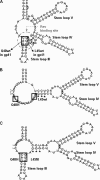Treatment with the fusion inhibitor enfuvirtide influences the appearance of mutations in the human immunodeficiency virus type 1 regulatory protein rev
- PMID: 19124665
- PMCID: PMC2704662
- DOI: 10.1128/AAC.01067-08
Treatment with the fusion inhibitor enfuvirtide influences the appearance of mutations in the human immunodeficiency virus type 1 regulatory protein rev
Abstract
The gp41-encoding sequence of the env gene contains in two separate regions the Rev-responsive elements (RRE) and the alternative open reading frame of the second exon of the regulatory protein Rev. The binding of Rev to the RRE allows the transport of unspliced/singly spliced viral mRNAs out of the nucleus, an essential step in the life cycle of human immunodeficiency virus type 1 (HIV-1). In this study, we have investigated whether the fusion-inhibitor enfuvirtide (ENF) can induce mutations in Rev and if these mutations correlate with the classical ENF resistance gp41 mutations and with viremia and CD4 cell count. Specific Rev mutations were positively associated with ENF treatment and significantly correlated with classical ENF resistance gp41 mutations. In particular, a cluster was observed for the Rev mutations E57A (E57A(rev)) and N86S(rev) with the ENF resistance gp41 mutations Q40H (Q40H(gp41)) and L45M(gp41). In addition, the presence at week 48 of the E57A(rev) correlates with a significant viremia increase from baseline to week 48 and with a CD4 cell count loss from baseline to week 48. By modeling the RRE structure, we found that the Q40(gp41) and L45(gp41) codons form complementary base pairs in a region of the RRE involved in Rev binding. The conformation of this Rev-binding site is disrupted when Q40H(gp41) and L45M(gp41) occur alone while it is restored when both mutations are present. In conclusion, our study shows that ENF pressure may also affect both Rev and RRE structures and can provide an excellent example of compensatory evolution. This highlights the multiple roles of ENF (and perhaps other entry inhibitors) in modulating the correct interplay between the different HIV-1 genes and proteins during the HIV-1 life cycle.
Figures




References
-
- Aquaro, S., R. D'Arrigo, V. Svicher, G. D. Perri, S. L. Caputo, U. Visco-Comandini, M. Santoro, A. Bertoli, F. Mazzotta, S. Bonora, V. Tozzi, R. Bellagamba, M. Zaccarelli, P. Narciso, A. Antinori, and C. F. Perno. 2006. Specific mutations in HIV-1 gp41 are associated with immunological success in HIV-1-infected patients receiving enfuvirtide treatment. J. Antimicrob. Chemother. 58:714-722. - PubMed
-
- Benjamini, Y., and Y. Hochberg. 1995. Controlling the false discovery rate: a practical and powerful approach to multiple testing. J. R. Stat. Soc. B 57:289-300.
-
- Demart, S., F. Ceccherini-Silberstein, S. Schlicht, S. Walcher, H. Wolff, M. Neumann, V. Erfle, and R. Brack-Werner. 2003. Analysis of nuclear targeting activities of transport signals in the human immunodeficiency virus Rev protein. Exp. Cell. Res. 291:484-501. - PubMed
-
- Freed, E. O., and M. A. Martin. 2001. HIVs and their replication, p. 1971-2041. In D. M. Knipe, P. M. Howley, D. E. Griffin, R. A. Lamb, M. A. Martin, B. Roizman, and S. E. Straus (ed.), Fields virology, 4th ed., vol. II. Lippincott Williams & Wilkins, Philadelphia, PA.
Publication types
MeSH terms
Substances
LinkOut - more resources
Full Text Sources
Research Materials

